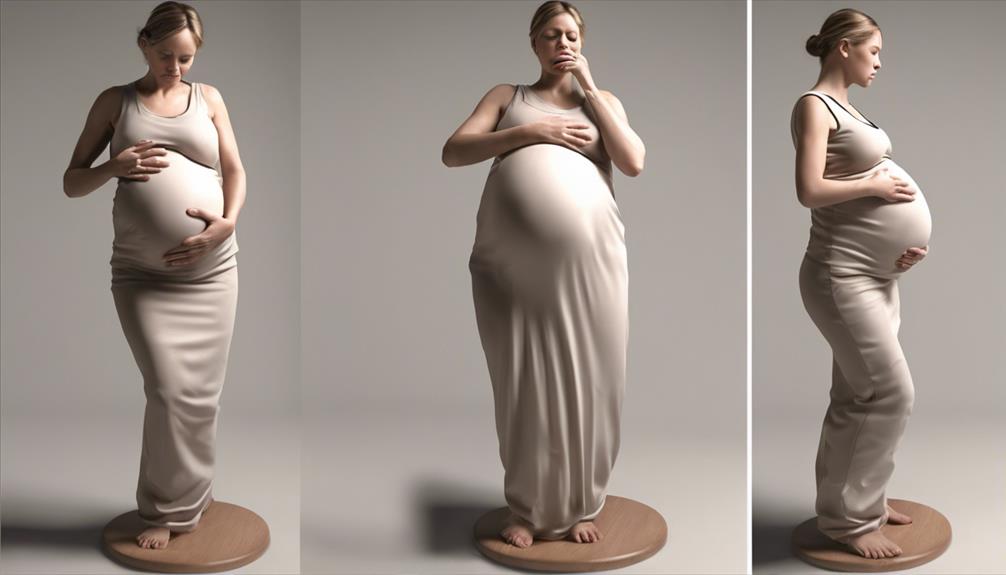As parents-to-be, we often ponder about the specific time when the second trimester starts. The boundaries aren’t always straightforward, yet there are significant signs that assist us in identifying this crucial phase of pregnancy.
By understanding these subtle yet significant changes in our bodies and the baby's development, we can navigate this period with more confidence and anticipation.
Let's explore the telltale signs that signal the start of the second trimester and what to expect as we progress further into this transformative journey.
Key Takeaways
- Second trimester begins around week 14.
- Symptoms like morning sickness decrease.
- Baby's movements (quickening) may be felt.
- Uterus expands, leading to a visible baby bump.
Signs of Second Trimester Beginning
Upon reaching approximately week 14 of pregnancy, noticeable changes mark the beginning of the second trimester. During this time, the incessant morning sickness and overwhelming fatigue that characterized the first trimester begin to diminish, providing a welcome relief for many expectant parents.
As we progress into the second trimester, the baby continues to grow and develop at a rapid pace. The risk of miscarriage decreases noticeably, offering a sense of reassurance as the pregnancy advances. Around this time, some may start to feel the baby's movements, known as quickening, a thrilling experience that fosters a deeper connection with the growing life inside.
Additionally, the uterus expands further to accommodate the baby's increasing size, which may result in some weight gain for the expectant parent. The second trimester is truly a transformative time, filled with both physical changes and the anticipation of welcoming a new life into the world.
Physical Changes in Second Trimester
Entering the second trimester, expectant parents may notice significant physical changes as the uterus expands to accommodate the growing fetus, leading to the emergence of a visible baby bump. This period brings about a mix of changes in both the mother's body and the developing fetus.
Some key physical changes and experiences during the second trimester include:
- Increased Energy Levels: Many expectant parents find that their energy levels rise in the second trimester, providing a welcome relief from the fatigue often experienced in the first trimester.
- Maternal Weight Gain: Along with a visible baby bump, maternal weight gain and changes in body shape, such as a fuller belly, are common occurrences as the pregnancy progresses.
- Decreased Symptoms: Symptoms like morning sickness and breast tenderness typically lessen during the second trimester, allowing parents to enjoy a more comfortable phase of pregnancy.
These changes reflect the ongoing process of fetal development, including organ growth and the emergence of distinct features, marking an exciting phase in the journey towards parenthood.
Fetal Development in Second Trimester
During the second trimester of pregnancy, fetal development progresses rapidly, with key sensory and physical milestones being reached. At around 14 weeks, the fetus begins to develop senses of smell and taste. Quickening, the first fetal movements, typically occurs at about 16 weeks, an exciting moment for many expectant parents. By 17 weeks, a waxy coating known as vernix caseosa forms on the fetus to protect its delicate skin. Around 22 weeks, tiny eyebrows start to become visible on the developing baby, adding to its unique features. As the second trimester progresses, by approximately 23 weeks, the fetus can recognize sounds, including the comforting cadence of the mother's voice. These advancements in fetal development during the second trimester highlight the intricate and miraculous journey of pregnancy. Below is a table summarizing some key milestones in fetal development during this period:
| Milestone | Timing | Description |
|---|---|---|
| Smell and Taste Development | 14 weeks | Senses of smell and taste begin to develop |
| Quickening | 16 weeks | First fetal movements are felt by the mother |
| Vernix Caseosa | 17 weeks | Waxy coating forms to protect the fetus's skin |
Monitoring Health in Second Trimester

As we progress into the second trimester, it becomes imperative to monitor the mother's health closely to guarantee a smooth and healthy pregnancy. Regular prenatal checkups starting around week 14 are essential for ensuring maternal well-being and fetal development. During these appointments, healthcare providers meticulously assess various aspects to track the progress of the pregnancy.
- Weight Gain: Monitoring weight gain is pivotal as it can indicate the overall health of both the mother and the baby.
- Blood Pressure: Regular checks on blood pressure help in identifying and addressing any potential issues such as gestational hypertension.
- Fetal Growth: Tracking the growth of the fetus ensures that the baby is developing as expected and provides insights into their overall health.
These checkups also involve screening for symptoms like headaches, swelling, and abdominal pain, which can be early indicators of complications. Additionally, monitoring baby movements and growth milestones, along with conducting diagnostic tests and screenings, play a pivotal role in maintaining a healthy pregnancy throughout the second trimester.
Key Milestones in Second Trimester
In the second trimester of pregnancy, fetal development progresses rapidly with notable milestones marking key stages of growth and maturation. Around 16 weeks, a significant milestone called quickening occurs, which is when the mother feels the first fetal movements. By week 18, the baby may weigh as much as a chicken breast, showcasing substantial fetal growth.
Another important milestone in skin development is the formation of vernix caseosa, a protective waxy coating that appears around 17 weeks. As sensory development progresses, around 23 weeks, the fetus begins to recognize sounds, including the comforting tones of the mother's voice.
It's essential during this period to focus on a healthy pregnancy diet to support the increasing weight gain and overall well-being of both the mother and the growing baby. Regular check-ups with a healthcare provider become even more vital in the second trimester to monitor these milestones and make sure the pregnancy is progressing as expected.
Frequently Asked Questions
When Am I Officially in My Second Trimester?
We officially enter the second trimester at week 14 of pregnancy. This period lasts from week 14 to week 27 and is marked by reduced risk of miscarriage, important fetal developments, and alleviation of certain symptoms like morning sickness.
What Marks the Start of the Second Trimester?
Entering the second trimester brings relief from morning sickness and fatigue for many. As we approach week 14, the risk of miscarriage decreases notably while fetal growth accelerates. It's a time of change and increasing energy.
What Week Count Is the Second Trimester of Pregnancy?
Week 14 to week 27 is the second trimester of pregnancy, encompassing around 14 weeks. It's a time when many experience reduced morning sickness and fatigue, with significant fetal development milestones like distinct facial features forming.
When Does Second Trimester Start 13 or 14?
The second trimester officially starts at week 14 of pregnancy. This is a significant milestone as many women begin to see a decrease in symptoms like morning sickness. Fetal development progresses rapidly from this point.
Conclusion
As we commence on the journey into the second trimester of pregnancy, we're entering a period of growth and transformation.
Just as the baby is rapidly developing and reaching key milestones, we too are evolving both physically and emotionally.
Embrace this time of change with open arms, symbolizing the beginning of a new chapter filled with hope, excitement, and the promise of new life.









